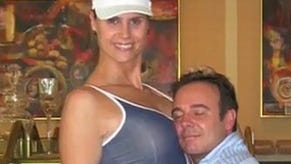Infinite Moo: Why Dynasty Warriors can be milked forever
How many times can you make a game about the same series of historical events? Until you get it just right, Omega Force believes.
The Dynasty Warriors series is often criticised for failing to innovate between each iteration - although given the conventions of hack-and-slash, it's difficult to see why this argument doesn't apply equally to, say, shooters. In fact, aficionados actually find a number of changes to love and hate between each iteration, in terms of gameplay, narrative and cast.
Dynasty Warriors 6, the first entry on the PlayStation 3, introduced significant changes to the charge-combo system used in the expansive Dynasty Warriors 5 generation. The new system had an increased focus on blocking, ripostes and precise timing rather than memorising movesets - a design decision which proved highly controversial, especially since the casual difficulties proved to be even more accessible to the button-mashing crowd than ever before, bringing poor reviews.
With the next release, Omega Force reversed its position, re-introducing the familiar combo system, bringing back dismissed cast members, and even satisfying the desires of Romance of the Three Kingdoms geeks by introducing a new faction to complete the story.
Dropping Dynasty Warriors 5 and 6's character based narratives, in which each general had his own campaign, Dynasty Warriors 7 had four campaigns, one for each factions, and gave the player no choice in which character to play - a system much closer to earlier games in the series.
This flip-flopping back and forth, which occurs to some degree in every iteration, means each new numbered core entry and its associated spin-offs is distinct from the others. It's almost like prototyping with completed games, and that makes it hard to guess what Omega Force are aiming to achieve. I asked Akihiro Suzuki, the man behind Dynasty Warriors 7 and its recent stand-alone expansion Xtreme Legends what drives the developer's constant evolution.
His answer, in brief, was love for Romance of the Three Kingdoms, the classical Chinese historical novel the franchise is based on.
"It's always our focus to bring to bring as many of those historical episodes from that source material through in our games," Suzuki explained.
"In the case of things like new characters for example, obviously Romance of the Three Kingdoms is a very vast story, with a ton of characters. It's impossible to completely cover them all in a single game. So we like to expand on that as we go."
The producer segued briefly to mention that the team wants to make battlefields and combat more realistic, but it was apparent that it's the narrative heart of the series which most interests him.
"With Dynasty Warriors 7, our aim was to make the story easier to understand - especially for people in the West, who haven't grown up with the source material like we have in Japan and Asia," he enthused.
"We've had a lot of feedback that it was a lot easier to know what was going on, and who these people were, so we definitely want to continue with this style."
Dynasty Warriors has a huge cast - and fans are always clamouring for more and more characters to appear in each game, with each cut bringing anguish. Balancing such a huge roster is difficult from a gameplay point of view, but also in terms of ensuring each historical figure is painted distinctly from the rest.
"Basically we start with the source material as a base, just to find out what kind of characters they were to begin with - what personality traits they might have, how they acted," Suzuki said of the writing process.
"We find that have to find make some slight tweaks and arrange these events to help them stand out from one another."
After that, the characters almost write their own lines.
"Once we do that, we take those slightly arranged characters and put them back in the historical scenarios. Then we say 'okay, we'll put this character in this particular situation. We've made these adjustments to how thinks and acts and speaks, so we'll so how that plays together with whatever course the story will take.'"
The characters in Dynasty Warriors are so removed from everyday life that it's almost impossible to understand the world they lived in - a China which was the centre and the entirety of a world locked in constant, bloody warfare. Omega Force's re-interpretation lends these historical figures a new life, making their actions and motivations feel immediate, so that fans are passionately devoted to their favourites.
"I personally prefer Xiahou Dun from Wei," Suzuki confessed.
"Because he's awesome?" I asked, thinking of the historical warrior who is said to have eaten his own eyeball from an arrow after being shot in the face, much to the horror of the enemy troops who witnessed it. And probably everyone else.
"He's cool, he's tough, and he has a good moveset," Suzuki agreed emphatically.
"But, for example, the game designer back on Dynasty Warriors 2 - Mr Ogasawara - he's always been a big Zhao Yun fan. He's kind of served as a main character, the face of the franchise for a long time. It had a lot to do with his personal preference."
When I spoke to Kenichi Ogasawara, producer of Dynasty Warriors Next and franchise veteran, he was suitably humble about his role in creating the instantly recognisable character, which was considered quite an aesthetic departure when the first Dynasty Warriors, a PSOne beat-'em-up, debuted.
The designer didn't feel drawing from historical sources alone would make the characters distinctive enough. Zhao Yun is generally shown as a mature general with a long moustache, middling eyebrows, and ornate armour - there's little to distinguish him from his peers, and by modern standards, his design is pretty dull.
"We were thinking, we need something else, something more attractive, more…"
"Bishonen?" I offered, a familiar term among Western otaku, roughly meaning "pretty boy".
"Yes!" both producer and translator agreed. "That's how the idea came up."
Ogasawara isn't an artist, but he did oversee the character design in line with this new, and now famous, aesthetic. Not because of Zhao Yun's historical role, but because Ogasawara is a massive fan.
"When I joined the company, I was a big fan of the Three Kingdoms," Ogasawara reminisced.
"I wanted to make Zhao Yun some kind of superhero or superman, who has all the skills and features, that makes him the best character in the game. That was the reason."
A superman he certainly is. The Dynasty Warriors mindset is "one against one thousand", and characters tear through opposition, even in the hands of novices. Most beginners can get through by mashing just one button and steering.
And yet, ramp the difficulty up, and things get out of hand quickly - the hardcore game could almost be considered an entirely different experience, relying on expert knowledge of enemy behaviour and almost fighter-like combat precision.
"It's kind of a difficult line to walk," Suzuki admitted, adding that expansions are one way of ensuring the game has multiple audiences.
"Xtreme Legends is really targeted to those more hard core fans, because it's new characters, new moves and new weapons, and that takes it to a new level," he said.
Dynasty Warriors 7 Xtreme Legends is out now on PlayStation 3. It functions as a stand-alone title but can also be used in conjunction with Dynasty Warriors 7.











